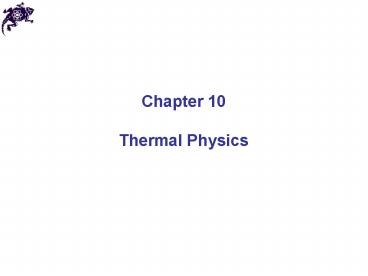Thermal Physics - PowerPoint PPT Presentation
Title:
Thermal Physics
Description:
Chapter 10 Thermal Physics Temperature Thermodynamics branch of physics studying thermal energy of systems Temperature (T), a scalar measure of the thermal ... – PowerPoint PPT presentation
Number of Views:133
Avg rating:3.0/5.0
Title: Thermal Physics
1
Chapter 10 Thermal Physics
2
- Temperature
- Thermodynamics branch of physics studying
thermal energy of systems - Temperature (T), a scalar measure of the
thermal (internal) energy of a system - SI unit K (Kelvin)
- Kelvin scale has a lower limit (absolute
- zero) and has no upper limit
3
- Kelvin scale
- Kelvin scale is defined by the temperature of
the triple point of pure water - Triple point set of pressure and temperature
values at which solid, liquid, and gas phases can
coexist - International convention
- T of the triple point of water is
4
- The zeroth law of thermodynamics
- If two (or more) bodies in contact dont change
their internal energy with time, they are in
thermal equilibrium - 0th law of thermodynamics if bodies are in
thermal equilibrium, their temperatures are equal
5
- Measuring temperature
- Temperature measurement principle if bodies A
and B are each in thermal equilibrium with a
third body C, then A and B are in thermal
equilibrium with each other (and their
temperatures are equal) - The standard temperature for the Kelvin scale is
measured by the constant-volume gas thermometer
6
Constant-volume gas thermometer
7
- Celsius and Fahrenheit scales
- Celsius scale
- Fahrenheit scale
8
Chapter 10 Problem 3
Convert the following temperatures to their
values on the Fahrenheit and Kelvin scales (a)
the boiling point of liquid hydrogen, 252.87C
(b) the temperature of a room at 20C.
9
- Thermal expansion
- Thermal expansion increase in size with an
increase of a temperature - Linear expansion
- Volume expansion
10
Thermal expansion
11
Chapter 10 Problem 14
A cube of solid aluminum has a volume of 1.00 m3
at 20C. What temperature change is required to
produce a 100-cm3 increase in the volume of the
cube?
12
- Temperature and heat
- Heat (Q) energy transferred between a system
and its environment because of a temperature
difference that exists between them - SI Unit Joule
- Alternative unit calorie (cal)
13
- Avogadros number
- Mole amount of substance containing a number
of atoms (molecules) equal to the number of atoms
in a 12 g sample of 12C - This number is known as Avogadros number (NA)
- NA 6.02 x 1023 mol -1
- The number of moles in a sample
- N total number of atoms (molecules)
- m total mass of a sample, m0 mass of a single
atom (molecule) M molar mass
14
- Ideal gases
- Ideal gas a gas obeying the ideal gas law
- R gas constant
- R 8.31 J/mol K
- kB Boltzmann constant
- kB 1.38 x 1023 J/K
15
- Ideal gases
- The gas under consideration is a pure substance
- All molecules are identical
- Macroscopic properties of a gas P, V, T
- The number of molecules in the gas is large, and
the average separation between the molecules is
large compared with their dimensions the
molecules occupy a negligible volume within the
container - The molecules obey Newtons laws of motion, but
as a whole they move randomly (any molecule can
move in any direction with any speed)
16
- Ideal gases
- The molecules interact only by short-range
forces during elastic collisions - The molecules make elastic collisions with the
walls and these collisions lead to the
macroscopic pressure on the walls of the
container - At low pressures the behavior of molecular gases
approximate that of ideal gases quite well
17
Ideal gases
18
- Ideal gases
- Root-mean-square (RMS) speed
19
- Translational kinetic energy
- Average translational kinetic energy
- At a given temperature, ideal gas molecules have
the same average translational kinetic energy - Temperature is proportional to the average
translational kinetic energy of a gas
20
- Internal energy
- For the sample of n moles, the internal energy
- Internal energy of an ideal gas is a function of
gas temperature only
21
Chapter 10 Problem 30
A tank having a volume of 0.100 m3 contains
helium gas at 150 atm. How many balloons can the
tank blow up if each filled balloon is a sphere
0.300 m in diameter at an absolute pressure of
1.20 atm?
22
- Distribution of molecular speeds
- Not all the molecules have the same speed
- Maxwells speed distribution law
- Nv?v fraction of molecules with speeds in the
range from v to v ?v
23
- Distribution of molecular speeds
- Average speed
- RMS speed
- Most probable speed
24
Questions?
25
- Answers to the even-numbered problems
- Chapter 10
- Problem 28
- 3.0 mol
- (b) 1.80 1024 molecules
26
Answers to the even-numbered problems Chapter 10
Problem 42 3.34 105 Pa































